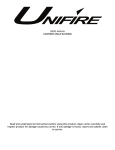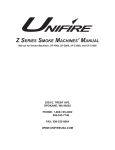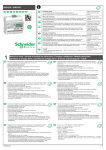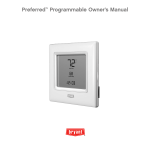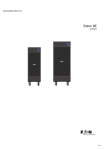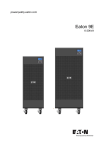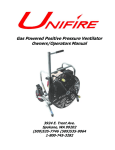Download Unifire Saw Specifications
Transcript
High Performance Ventilation Chain Saws 3924 E. Trent Ave. Spokane, WA 99202 (509)535-7746 (509)535-9064 1-800-745-3282 Contents Congratulations.... CONTENTS On your purchase of the worlds finest high performance, ventilation saw. This saw has been designed to meet the rugged requirements of the fire service. To ensure maximuim performance and reliability this saw’s carburator should be set for the altitude it is intended to run at, and the R.P.M. should be set at 13,500. This can be achieved through the dealer you purchased the saw from or at any authorized Unifire dealer. If you should need assistance in locating the nearest dealer please call 1-800745-3282 and ask for our customer service deptartment. We would sincerely like to thank you for your purchase of Unifire’s ventilation saw, one of the team products. Safety Instructions Personal protective equipment General Safety precations Avoiding Kickback Cutting Equipment Before Using A New Saw Start and Stop Procedures and hints Read the instructions carefully. Check all cutting equipment is all correctly fitted and adjusted. Refuel and start the saw. Check carburetor settings. Do not use the saw until sufficient chain oil has reached the chain. WARNING! Under no circumstances may the design of the machine be modified without the permission of the manufacturer. Always use genuine spare parts/accessories. Non Autorized modifications and/or accessories can result in serious personl injury or the death of the operator or others. The warranty does not cover damage or liability caused by the non-authorized accessories or replacement parts. WARNING! The engine exhaust from this product contains chemicals known to the state of California to cause cancer, birth defects or other reproductive harm. The warranty does not cover damage or liability caused by the non-authorized accessories or replacement parts. What is What Saw parts diagram Assembly Mounting guide bar and chain Fuel Handling Fuel mix Fueling Maintenance Air Filter Spark Plug Tensioning the recoil spring Changing recoil spring Carburetor Daily maintenace Weekly maintenance Monthly maintenance Depth Guage Instructions 3924 E. Trent Ave. Spokane, WA 99202 Phone: (509)535-7746 Fax: (509)535-9064 1-800-745-3282 www.unifireusa.com Page 1 Start and Stop Cold Engine Start CHAIN BRAKE: Disengage the cain brake by pulling the hand gaurd towards the front handle. Grip the front handle with your left hand and hold the saw down by putting your right foot in the rear handle. Pull the starter handle with your right hand and pull out the starter cord slowly until the starter pawls engage. Then pull sharply. IGNITION: Move the ignition switch to start position CHOKE: Set the choke control in choke position. FAST IDLE: Combined choke/fast idle is received when the choke is moved to choke position. This saw is fitted with a decompression valve (A): Press the valve to reduce the pressure in the cylinder and make starting easier. Always use the decompression valve when starting the saw. Once the saw has started the valve will automatically return to its original setting. Push the choke control immediately when the engine ignites and make repeated starting attempts. When the engine starts, rapidly give full throttle. Then the trottle latch will disengage. CAUTION! Do not release the starter handle from fully pulled out position as this can cause damage to the saw. Stop The engine is stopped by switching off the ignition. Warm Engine Use the same procedure as for starting cold engine but without choke. Fast idle is received by first set the choke control in choke position, and then back again. WARNING! Never start the saw engine without the bar, chain and clutch cover assembled. Always move saw away from fueling area. Place the saw on clear ground, and make sure you have secure footing Page 2 Fuel Handling Gasoline This engine is ceritified to operate on unleaded gasoline. Mix (shake) the fuel mixture thoroughly before filling the saw’s fuel tank. Do not mix more than the max one months supply of fuel. Use good quaility unleaded gasoline. The lowest recommended octane rating is 87. If the saw is not used for sometime the fuel tank should be emptied and cleaned. When working at continuous high revs a higher octane is recommended. This engine is certified to operate on unleaded gasoline. Two-stroke Oil For the best results use HUSQVARNA two-stroke oil, which is especially developed for chain saws. Mixing ratio 1:50 (2%). Never use two stroke oil intended for water cooled outboard engines, or so-called outboard oil. Chain Oil Never use oil intended for four stroke engines. The chain lubrication system is automatic. Always use special chain oil with good adhesive characteristics. Never use waste oil! Lit. 5 10 20 US GALLON US fl. oz. 1 2 1/2 6 1/2 1 1/2 5 Mixing Lit. 0, 10 0, 20 0, 30 0, 40 15 It is important that the oil is the right viscosity according to air temperature. Fueling In temperatures below 0 degrees C some oils become too viscous. This can overload the oil pump and result in damage to the oil pump components. Always mix the gasoline and oil in a clean container intended for fuel. Clean around the fuel cap. Clean the fuel and chain oil tanks regularly. The fuel filter should be changed at least once a year. Start by filling half the gasoline to be used. Then add the entire amount of oil. Mix. (shake) Add remaining gas. The volume of chain oil and fuel tanks are adjusted to each other. Therefore, always fill the chain oil and fuel at the same time. 12 7/8 Page 3 Assembly and Maintenance Mounting Guide Bar and Chain Always wear gloves when working with the chain, in order to protect your hands from injury! Check that the chain brake is in disengaged position by moving the front hand guard towards the front handle. Hold up the tip of the bar and tighten the chain. The chain is correctly tensioned when there is no slack on the underside of the bar, but it can still be turned easily by hand. Hold up the bar tip and tighten the bar nuts with the combination wrench. When fitting a new chain the chain tension has to be checked frequently until it is run-in. And then check the tension on a regular basis. Take off the bar nuts and remove the clutch cover. Take off the transportation ring (A). Starter Device Assembly Fit the bar over the bolts. Place the bar in its rearmost position. Place the chain over the drive sprocket and in the groove on the bar. Begin on the top side of the bar. Make sure that the edges on the cutting links are facing forward on the top side. Fit the clutch cover and locate the chain adjuster pin in the hole on the bar. Check that the drive links of the chain fit correctly on the drive sprocket and that the chain is in the groove on the bar. Tighten the bar nuts finger tight. Tension the chain by using the combination wrench. Turn clockwise. The chain should be tensioned until it fits snugly. Assemble the starter device, by pulling the starter cord out first, then place the starter against the crankcase. Then slowly release the starter cord so that the pulley engages with the pawls. Assemble and tighten the screws, which hold the starter Adjustment of oil pump The oil pump is adjustable. Adjustments are made by turning the screwdriver or combination spanner. Turning the screw clockwise will reduce the oil flow and turning the screw anti-clockwise will increase the oil flow. Recommended settings: Bar Bar Bar Bar -15”:1 turn from the closed position 15”-18”: 2 turns from the closed position 18”-24”: 3 turns from the closed position 24”- :4 turns from the closed position Page 4 Maintenance 3 Stage Air Filtration Changing a broken starter cord The air filter must be regularly cleaned from dust and dirt in order to avoid: - Carburetor malfunctions - Starting problems - Engine power reduction - Unnecessary wear on engine parts - Abnormal fuel consumption Loosen the screws, that hold the device against the crankcase and remove the starter device Clean the air filter daily or more often if the air is exceptionally dusty in the working area. Disassemble the air filter by removing the air filter cover and unscrew the filter. When reassembling, make sure that the filter is tight against the filter holder. Pull out the cord approx. 30 cm and lift it up into the notch in the pulley. Zero-set the recoil spring by letting the pulley rotate slowly backwards. Undo the screw in the centre of the pulley and remove the pulley. A more thorough cleaning of the filter is obtained by washing it with soap and water. Insert and fasten a new starter cord in the pulley. Wind approx. 3 turns of the starter cord on to the pulley. Assemble the starter pulley against the recoil spring, sothe end of the spring engages to the pulley. Fit the screw in the center of the the pulley. Carry the starter cord through the hole in the starter housing and the starter handle. Make a knot on the starter cord. Spark Plug Tensioning the recoil spring Clean the filter by brushing or shaking it. The spark plug condition is influenced by: - An incorrect carburetor setting - Wrong fuel mixture (to much oil in gasoline) - A dirty air filter If the engine is low on power, difficult to start or runs poorly at idling speed, always check the spark plug first. If the spark plug is dirty, clean it and check electrode gap. Readjust if necessary. The correct gap is 0,5 mm (0, 020”) The spark plug should be replaced after about a month in operation or earlier if the electrodes are badly eroded. Lift the sarter cord up in the notch on the starter pulley and turn the starter pulley 2 turns clockwise. NOTE! Check that the starter pulley can be turned at least half a turn, when the starter cord is entirely pulled out. Changing the broken recoil spring Lift starter pulley Dissasemble the recoil spring by tapping the pulley lightly against a working bench. If the spring pops out when assembling it should be mounted again, out and in the center. Lubricate the recoil spring with thin oil. Assemble the starter pulley, and tension the recoil spring. Page 5 Maintenance Carburetor Low speed needle L The Unifire Pro-Saw has been designed and manufactured to specifications that reduce harmful emissions. After your unit has been run 810 tanks of fuel the engine has broken in. To ensure that your unit is at peak performance and producing the least amount of harmful emissions after break in, adjust your carburetor for optimum operating conditions. Turn the low speed needle L clockwise until the stop. If the engine has bad acceleration or erratic idling, turn the L needle counter-clockwise until good idling and acceleration. Final setting for the idling speed T Adjust the idling speed with the screw T. If it is necessary to re-adjust, first turn the idle speed adjusting screw T clockwise, until the chain starts to rotate. Then turn, counter-clockwise until the chain stops. A correctly adjusted idle speed setting occurs when the engine runs smoothly in every position. It should also be good margin to the rpm when the chain starts to rotate. Operation The carburetor governs the engines speed via the throttle. Air/fuel are mixed in the carburetor. The air/ fuel mixture is adjustable. To take advantage of the engines optimal output the setting must be correct. The setting of the carburetor means that the engine is adapted to local conditions, for example the climate, altitude, fuel and the type of 2-stroke oil. The carburetor has three adjustment possibilities. L: Low speed jet H: High speed jet T: Adjustment screw for idling. The fuel quantity required in relation to the air flow, provided by opening the throttle, is adjusted by the L and H jets. If they are screwed clockwise the air/fuel ratio becomes leaner (less fuel) and if they are turned counter clockwise the ratio becomes richer (more fuel). A leaner mixture gives a higher engine speed and a richer mixture give a lower engine speed. The T screw regulates the idling speed. If the screw T is turned clockwise this gives a higher idling speed; counter-clockwise a lower idling speed. Fine Adjustment When the saw has been “run-in” the carburetor should be finely adjusted. The fine adjustment should be carried out by a quailified person. First adjust the L-jet, then the idling screw T and then the H-jet. High speed needle H The high speed needle H influences the power of the saw. A too lean adjusted high speed needle H (high speed needle H closed too much) gives overrevs and damages the engine. Turn the high speed needle H counter clockwise until the stop. If the engine runs roughly, turn the high speed needle slowly the miniumum amount clockwise until the engine runs smoothly. The high speed needle H is correctly set when the saw “4-cycles” a little. If the saw “whistles” the setting is too lean. If there is too much exhaust gas at the time as the saw ”4-cycles” much, the setting is too rich. Turn the high speed needle H until the setting sounds correct. NOTE! For optimum setting of the carburetor, contact a quailified servicing dealer who has a revolution counter at his disposal. Correctly adjusted carburetor A correctly adjusted carburetor means that the saw accelerates without hesitation and the saw 4-cycles a little at max speed. Furthermore, the chain must not rotate idling. A too lean adjusted low speed needle L may cause starting difficulties and bad acceleration. A too lean adjusted high speed needle H gives lower power-less capacity, bad acceleration and/or damage to the engine. A too rich adjustment of the two speed needles L and H gives acceleration problems or too low working speed. Page 6 Maintenance Daily Maintenance Weekly Maintenance 1. Check the throttle trigger for smooth operation. If and binding occurs, or if engine fails to return to idle, the saw should be taken to your dealer before it is used again. Also be sure that the trigger cannot be pulled until the throttle trigger lockout is depressed. 1. Check that the AV elements are not soft or torn. 2. Clean the chain brake and check its function according to the instructions. Make sure that the chain catcher is undamaged. Otherwise replace it immediately. 3. Clean or replace the air filter as necessary. Check for damage or holes. 4. The bar should be turned daily for more even wear. Check the lubrication hole in the bar, to be sure it is not clogged. Clean the bar groove, if the bar has a sprocket tip, this should be lubricated. 5. Check the function of the oiler to be sure the bar and chain receive proper lubrication. 6. Sharpen the chain and check its tension and condition. Check the drive sprocket for wear. Replace if necessary. 7. Check the starter and starter cord for wear or damage. Clean the air intake slots on the starter housing. 8. Check for loose nuts and screws and retighten if necessary 2. Lubricate the clutch drum bearing. 3. File off burrs, if any, on the side bar. 4. Clean spark plug and check gap. 5. Check the starter and the recoil spring. Clean the fins on the flywheel. 6. Clean the cooling fins on the cylinder. 7. Clean or change the screen in the muffler. 8. Clean the carburetor body and air box. Monthly Maintenance 1. Check the brake band on the chain brake for wear. 2. Check the clutch centre, clutch drum and clutch spring for wear. 3. Clean the outside of the carburetor. 4. Change the fuel filter. 5. Clean the inside of the fuel tank. 6. Clean the inside of the oil tank. 7. Check all cables and connections. 8. Change the spark plug. 9. Change the air filter. Page 7 Depth Guage Installation Depth Guage Installation Instructions TOOLS REQUIRED: 1/2 inch wrench (or 13mm) Loctite 272-(provided) 17/64 Drill Bit Center Punch 6. Plunge the gauge several times to check for binding. Use a spray lubrication such as WD 40 for easy sliding. 1. Remove the Bar from the powerhead. Clean bar if it has been used. 2. Mark the bar for hole positions using the template provided. For precise drilling use a center punch. 3.. Replace the bar onto the powerhead and install chain. Adjust chain to proper tension. NOTE: SPRING TENSION MAY DECREASE SOMEWHAT WITH EXTENSIVE USE. TO RESTORE TENSION, REMOVE THE SPRING AND STRETCH A COUPLE OF INCHES AND THEN REPLACE SPRING. WARNING: CHAIN TENSION MUST BE MONITORED DURING USE. IF THE CHAIN BECOMES LOOSE IT MAY CAUSE DAMAGE OR INJURY. 4. Slide Depth Gauge over bar and chain. Line Depth Gauge studs up to holes in bar and insert. 5. Apply Loctite 272 (provided) to Depth Gauge studs. NOTE: USE LOCTITE 272 (OR COMPARABLE) ON ALL BOLTS AND NUTS ON THE DEPTH GAUGE. LOCTITE 272 IS A HIGH STRENGTH HEAT RESISTANT FASTENER ADHESIVE THAT MAY REQUIRE HEATING THE AREA AROUND THE FASTENER FOR REMOVAL. 6. Put stud nuts on and tighten. WARNING: Do not over tighten Depth Gauge stud nuts. Page 8 Depth Guage Instructions Depth Guage Instructions The depth guage is spring loaded. For a standard cut, simply push saw bar and chain into cut area, the guage will automatically slide back. When the saw is pulled out of the cut then the depth guage automatically springs forward to cover the bar and chain. 4. Once the cut has been started move saw to a 90 degree angle to achieve a precise cut at desired depth. Corrugated Roofs The pin can be positioned in a hole to set a plunge depth or can be set in a locked position to hold a specified cutting depth. Application 1. Using the positive stop pin set your cut depth and lock into position. 1. Position saw at a 30 degree angle, at the highest point. 2. Position saw at a 30 degree angle. (This angle is preset on your depth guage.) 2.Continue following the line of the roof, maintaining the same pattern. 3. For a standard cut push saw bar and chain into cut area, the guage will automatically slide back to your predetermined cut depth. 3.Tilt saw to maintain the angle in relation to the saw and cutting surface. 3.Always maintain the angle which is determined by the surface angle. Page 9 Unifire Pro-Saw Parts What is it? 1. Cylinder cover 2. Front Handle 3. Starter Cover 4 Chain oil tank 5. Starter Handle 6. Adjuster screw, carburetor 7. Choke Control/Start throttle lock 8. Rear handle 9. Stop switch, Ignition on/off switch 10. Fuel tank 11. Muffler 12. Bar tip sprocket 13. Saw chain 15. Saw bar 16. Bumper 17. Chain catcher. Catches chain if it jumps or breaks. 18. Clutch cover 19. Right hand guard. 20. Throttle control 21. Throttle Lock 22. Decompression valve 23. Combination spanner 24. Chain tensioning screw 25. Operators manual 26. Bar guard Page 10 27. Switch for heated handles.











